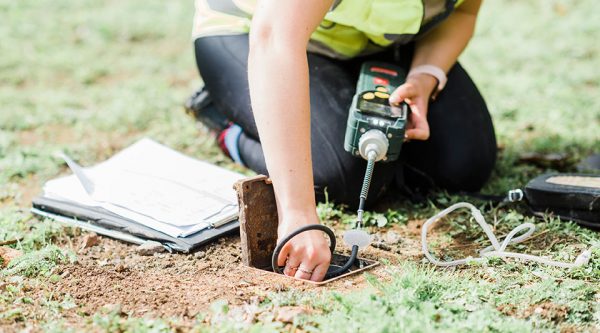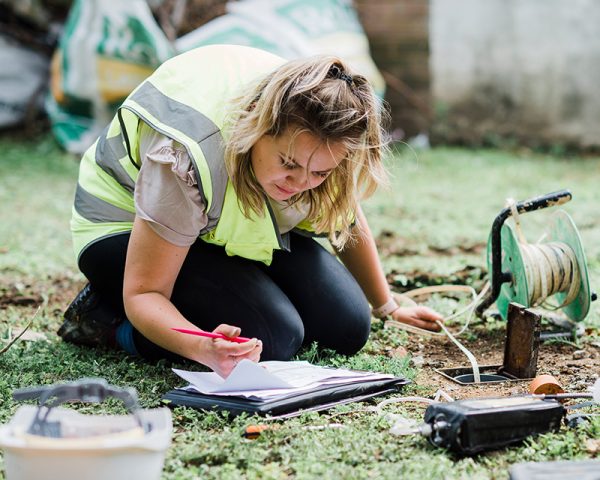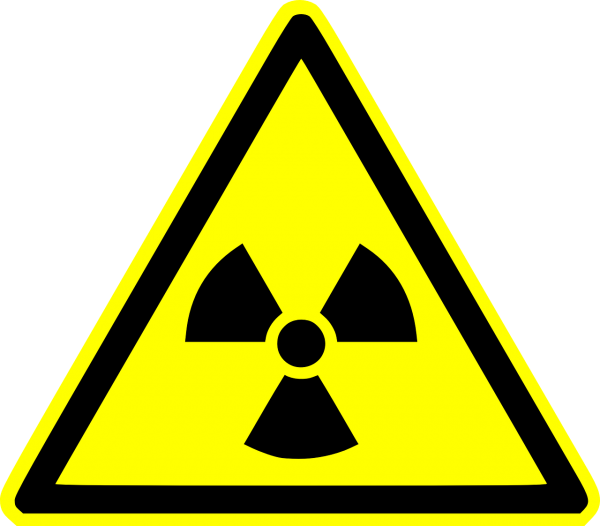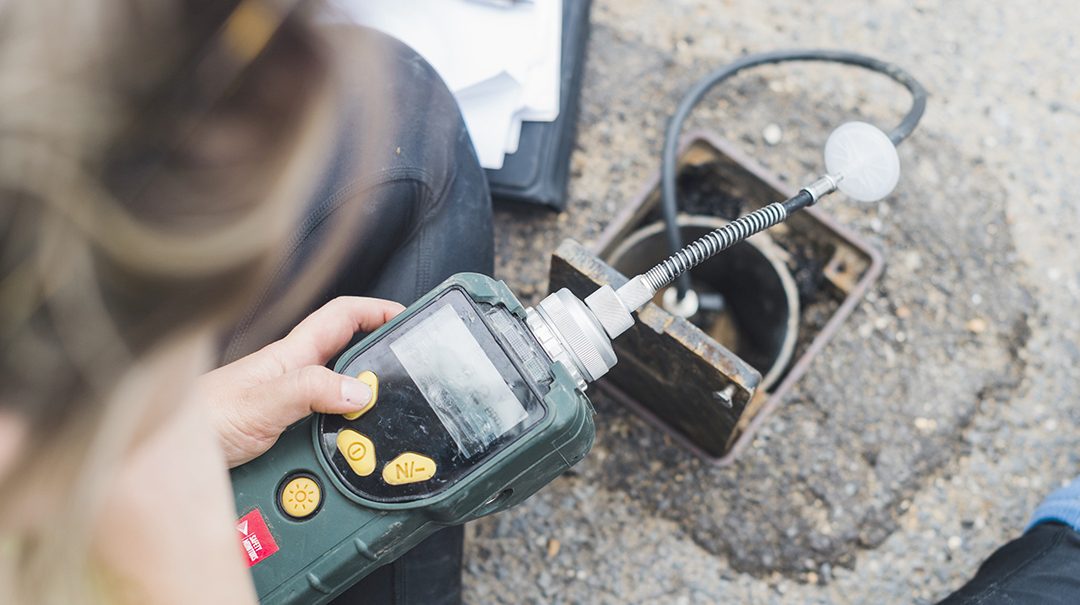Honing Our Ground Gas Skills Set
Geoenvironmental • Industry matters
 Ground & Water actively promotes and supports Continued Professional Development (CPD).
Ground & Water actively promotes and supports Continued Professional Development (CPD).
Two weeks ago eight engineers from Ground & Water took part in the A-Z of Ground-Gas course ran by GGS and PA GeoTechnical in Winchester. The team found the course to be extremely useful in providing detailed information about all things ground gas, as well as introducing the more specialised work including continuous ground gas monitoring and the practical elements of membrane installation and inspection. The course comprised eight units – introduction, collecting data, risk assessment methodologies, radon, principles and practices of gas protection, gas membrane installation, verification of protection systems and finally a summary of case studies where risk was not appropriately assessed. Below, Ground & Water Engineer Myles Finnerty summarises the key takeaway points.
 Introduction to Hazardous Ground-Gases
Introduction to Hazardous Ground-Gases
The introduction identified the seven main gases that are typically monitored – Carbon Dioxide and Nitrogen (Asphyxiants), Methane and Hydrogen (Explosives), Carbon Monoxide and Hydrogen Sulphide (Toxic) and Oxygen (Oxidant). Other hazardous gases that require consideration include Radon – a naturally occurring radioactive gas – as well as Volatile Organic Compounds (VOC’s), which is the collective term for several chemicals that have high vapour pressures at room temperature, which in some cases can adversely affect health.
A summary of the UK Guidance documents was also presented, along with details as to how certain threshold levels were informed and calculated. A whole host of documents were presented each covering at least one of the five following categories: investigation, risk assessment, design, installation and verification of ground gases and gas protection measures. It was interesting to hear how the development of guidance followed the natural cycle where ground gasses were investigated following on from accidents. These investigations led to guidance on how to adequately risk assess the risk posed and led to the design, installation and verification of protection measures. It is also worth noting that as this continues to be a hot topic within redevelopment, particularly where brownfield sites are concerned, guidance continues to be updated to the present day.
 Collecting Ground Gas Data
Collecting Ground Gas Data
The collection of ground gas data first relies upon a preliminary conceptual site model being drawn up. This is produced from a desk-based study of the site and follows the source – pathway – receptor – contaminant, linkage model. Once this information has been obtained, further details are required for each of the stages. For sources, the concentration, flow rate, generation rate and volume all need to be determined to adequately assess the risk posed. For pathways the key parameter to understand is the permeability. This is primarily dependent upon the geology underlying the source and receptor, as well as any natural or man-made features that may act as preferential pathways; such as former workings beneath a site, or obstructions to the flow, such as thick deposits of cohesive soils. Finally the receptors are considered during both construction and on completion of the project, as this informs the final gas protection measures required.
Risk Assessment Methodology Summaries
The risk assessment methodologies section began by showing us, that risk appetite and perception are entirely individual decisions and therefore what one person considers high risk, might only be low to moderate risk to another. Previously, as a result, this could lead to variations in how risk assessments were carried out along with the application of subsequent protection measures. To help inform a more standardised approach, guidance included within CIRIA C664 and BS8485:2015 developed frameworks, allowing site specific data along with the end use, to be considered before the required level of ground gas protection measures are determined.
The key take-home message from this section, was that the multiple lines of evidence approach should always be used when assessing the ground gas risk associated with a site. The better the understanding of the site conditions, combined with adequate investigation and monitoring data, allows a more appropriate risk level to be determined.
 Radon
Radon
Radon is a naturally occurring radioactive gas. It poses a risk to humans when inhaled and is the second highest cause of lung cancer in the UK; resulting in up to 2,000 fatal cancers per year. Radon primarily comes from the ground upon which homes are built and can pose a more elevated risk to sub-terranean structures such as basements, due to the increased surface area in contact with the ground. Monitoring within buildings can show great variability from room to room and therefore to get realistic results, monitoring should take place within a building once constructed at the lowest point possible; e.g. The lower ground floor or basement level. Seasonal fluctuations are also seen within the background levels of radon and therefore ideally over winter monitoring should take place; or if that is not possible, longer duration testing should be carried out in order to give greater confidence. We have seen more local councils paying greater attention to radon in recent months; particularly within the London area and it is something Ground & Water is looking at more closely with a view to services that we may be able to offer.
Principles and Practices of Gas Protection
Gas protection measures all work on the same principle…Breaking the pollutant linkage. There are multiple ways that gas protection measures can be included within the design of a building including: the type of slab used; the grade of concrete used for walls and floors; inclusion of a membrane or the inclusion of passive or active sub-floor dispersal layers. Once the gas protection measures for a site have been classified, clients should be aware of the processes that are required, covering the design and detailing required for the construction, follow on verification and in some cases, the need to carry out post construction monitoring to verify that the gas protection systems are working adequately in the most extreme cases.
Gas Membrane Installation and Verification
This section of the course was led by Neil Salvidge, who has over 20 years’ experience in the industry. Neil started the session with a quick introduction to the various methods of installation covering both taped systems and those where fusing is carried out. A lot of emphasis was put on the importance of the quality of installation and competency of workers involved in the installation of a gas membrane as it is one of the most crucial points in ground gas remediation strategies. Like many aspects of the construction industry, the best designed remediation strategies are irrelevant, if poor workmanship affects the final product. As a method of setting a benchmark for the industry, since 2009 CITB has run the NVQ Level 2 course on Gas Membrane Installation. However since there is no requirement for installers to be qualified, the uptake has been limited.
The verification of ground gas membranes is also of paramount importance. Given the rather varied experience of those installing them on-site and the volume of different membranes and products on offer, a final check of the work by a competent person must be carried out. This involves a site visit to confirm that the membrane across the footprint of the building has not been compromised and forms a perfect seal. Multiple methods can be used to carry this out, including visual inspections, integrity testing of the membrane and others including tracer gas testing. Crucially, this must be carried out correctly and logged formally for the discharging of planning conditions.
The ground gas course was very beneficial to confirm and refresh the knowledge we require to ensure we can deliver the best possible outcomes for our clients.
